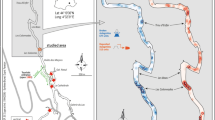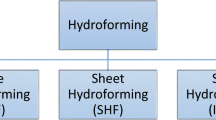Abstract
The Aterian lithic techno-complex that characterizes the late Middle Stone Age in North Africa is well known especially for its tanged or stemmed points. Recent techno-morphological and use-wear analyses have added new data to support the identification of the tang as the hafted portion of an artifact. They have also highlighted the presence of this attribute on tools other than projectile points, in contrast with the widespread idea that the tanged point is the Aterian fossile directeur. The design of this specific device, the tang, for hafting purposes is regarded as a great technical innovation that underlines a modern behavior. Our work provides new use-wear and experimental data, aiming at discussing the cognitive preconditions of this technical innovation that could have originated from a specific functional unit: the notch. Notches are quite abundant in the Aterian techno-complex. Our systematic study of this tool category from Aterian sites of the Jebel Gharbi allowed defining the notch per se as a techno-morpho-functional unit that was “applied” to different types of blanks, including “reused blanks,” which show a heavy patina on their surface. This functional unit has been used for various types of activities and can be found either alone on a blank or with multiple other units on the same blank, creating different tool morphologies. According to this interpretation, the tang could have been considered by Aterian populations as a new resulting variant of various possible combinations of notches, for defining and/or transforming the shape of a tool.
Résumé
Le techno-complexe lithique Atérien qui caractérise le Middle Stone Age final en Afrique du Nord est bien connu en particulier pour ses pointes pédonculées. Des analyses récentes soit techno-morphologiques soit tracéologiques ont ajouté de nouvelles données pour appuyer l’identification du pédoncule comme la partie emmanchée d’un artefact. Elles ont également mis en évidence la présence de cet attribut sur des outils différents des pointes de projectile, en contraste avec l’idée répandue de la pointe pédonculée comme fossile directeur Atérien. La création d’un dispositif spécifique, le pédoncule, pour l’emmanchement est considérée comme une grande innovation technique qui souligne le comportement moderne. Notre travail, au moyen de la tracéologie et d’expérimentations, fournit de nouvelles données visant à discuter les conditions cognitives de cette innovation technique qui pourrait provenir d’une unité fonctionnelle spécifique: l’encoche. La catégorie des encoches est assez abondante dans le techno-complexe Atérien. Notre étude systématique de cette catégorie d’outils à partir des sites atériens du Djebel Gharbi a permis de définir l’encoche comme une unité techno-morpho-fonctionnelle qui a été “appliquée” à différents types de supports, y compris des “supports réutilisés”, qui montrent une patine épaisse sur leur surface. Cette unité fonctionnelle a été utilisée pour divers types d’activités et se trouve soit seule sur un support ou avec plusieurs autres unités sur le même support, créant différentes morphologies d’outils. Selon cette interprétation, le pédoncule aurait pu être considéré par les populations atériennes comme une nouvelle variante résultant de diverses combinaisons possibles des encoches pour définir et / ou transformer la forme d’un outil.












Similar content being viewed by others
References
Barich, B. E. (2014). Northwest Libya from the early to late Holocene: New data on environment and subsistence from the Jebel Gharbi. Quaternary International, 320, 15–27.
Coppe, J., & Rots, V. (2017). Focus on the target. The importance of a transparent fracture terminology for understanding projectile points and projecting modes. Journal of Archaeological Science Reports, 17, 1–15. doi:10.1016/j.jasrep.2017.01.010.
Falzetti, S. (2014) Il significato funzionale degli strumenti litici ateriani (Late Middle Stone Age, Nord Africa): nuove prospettive di ricerca attraverso la sperimentazione e l’analisi delle tracce d’uso. Il caso studio del Jebel Gharbi (Libia settentrionale). MA dissertation, “Sapienza” University of Rome.
van Gijn, A. (2010). Flint in focus. Lithic biographies in the Neolithic and Bronze Age. Leiden: Sidestone Press.
Hallam, E., & Ingold, T. (2007). Creativity and cultural improvisation. An introduction. In E. Hallam & T. Ingold (Eds.), Creativity and cultural improvisation (pp. 1–24). London: Bloomsbury Academic.
Iovita, R. (2011). Shape variation in Aterian tanged tools and the origins of projectile technology: A morphometric perspective on stone tool function. PloS One, 6(12), e29029. doi:10.1371/journal.pone.0029029.
Kleindienst, M. R. (1998). What is the Aterian? The view from Dakhleh Oasis and the Western Desert, Egypt. In M. Marlow & A. J. Mills (Eds.), The Oasis paper 1: The proceedings of the First Conference of the Dakhleh Oasis Project (pp. 1–14). Oxford: Oxbow Books.
Lemorini, C. (2000). Reconnaitre des tactiques d'exploitation du milieu au Paléolithique Moyen. La contribution de l’analyse fonctionnelle. Etude fonctionnelle des industries lithiques de Grotta Breuil (Latium, Italie) et de La Combette (Bonnieux, Vaucluse, France). Oxford: BAR S858.
Massussi, M., & Lemorini, C. (2004–2005). I siti Ateriani del Jebel Gharbi: caratterizzazione delle catene di produzione e definizione tecno-funzionale dei peduncolati. Scienze dell’Antichità, 12, 19–28.
Rots, V. (2010). Prehension and hafting traces on flint tools: A methodology. Leuven: Leuven University Press.
Rots, V., & Plisson, H. (2014). Projectiles and the abuse of the use-wear method in a search for impact. Journal of Archaeological Science, 48, 154–165. doi:10.1016/j.jas.2013.10.027.
Scerri, E. M. L. (2013). The Aterian and its place in the North African Middle Stone Age. Quaternary International, 300, 111–130.
Spinapolice, E. E., & Garcea, E. A. A. (2013). The Aterian from the Jebel Gharbi (Libya): New technological perspectives from North Africa. African Archaeological Review, 30, 169–194.
Stoetzel, E., Campmas, E., Michel, P., Bougariane, B., Ouchaou, B., Amani, F., El Hajraoui, M. A., & Nespoulet, R. (2014). Context of modern human occupations in North Africa: Contribution of the Témara caves data. Quaternary International, 320, 143–161.
Tomasso, S., & Rots, V. (2017). What is the use of shaping a tang? Tool use and hafting of tanged tools in the Aterian of Northern Africa. Archaeological and Anthropological Sciences. doi:10.1007/s12520-016-0448-3.
Tringham, R., Cooper, G., Odell, G., Voytek, B., & Whitman, A. (1974). Experimentation in the formation of edge damage: A new approach to lithic analysis. Journal of Field Archaeology, 1, 171–196.
Van Peer, P. (1991). New observations about the Nile Valley Middle Palaeolithic: Safaha method and lateralization of Levallois Flakes. Paléorient, 17(2), 133–140.
Acknowledgments
Fieldwork on the Middle Stone Age in the Jebel Gharbi took place between 2000 and 2010, under the License for Archaeological Excavation from the Department of Antiquities in Libya (Law of Antiquities No. 3) to the Italian-Libyan Archaeological Project in the Jebel Gharbi, codirected by B.E. Barich and E.A.A. Garcea. It was funded by the Italian Ministries for Foreign Affairs and for Education, University and Research, and the Sapienza University of Rome, Italy. We sincerely thank Emilie Campmas, Emmanuelle Stoetzel, Aicha Oujaa, and Eleanor Scerri for kindly inviting us to take part in the stimulating session on “The Role of North Africa in the Emergence and Development of Modern Behaviours: Integrated Approach” that was organized at the 2016 SAfA meeting in Toulouse, France, and to contribute to this volume. Falzetti, Garcea, and Lemorini contributed in equal measure to the manuscript of this paper, Mironti made the technological analysis and the reproduction of the experimental replicas, and Drudi made the reproduction of the thrusting weapons and organized and conducted the thrusting experiments.
Author information
Authors and Affiliations
Corresponding author
Ethics declarations
Conflict of Interest
The authors declare that they have no conflict of interest.
Rights and permissions
About this article
Cite this article
Falzetti, S., Garcea, E.A., Lemorini, C. et al. From Aterian Notch to Aterian Tang: How to Make a Technological Invention. Afr Archaeol Rev 34, 525–541 (2017). https://doi.org/10.1007/s10437-017-9258-y
Published:
Issue Date:
DOI: https://doi.org/10.1007/s10437-017-9258-y




